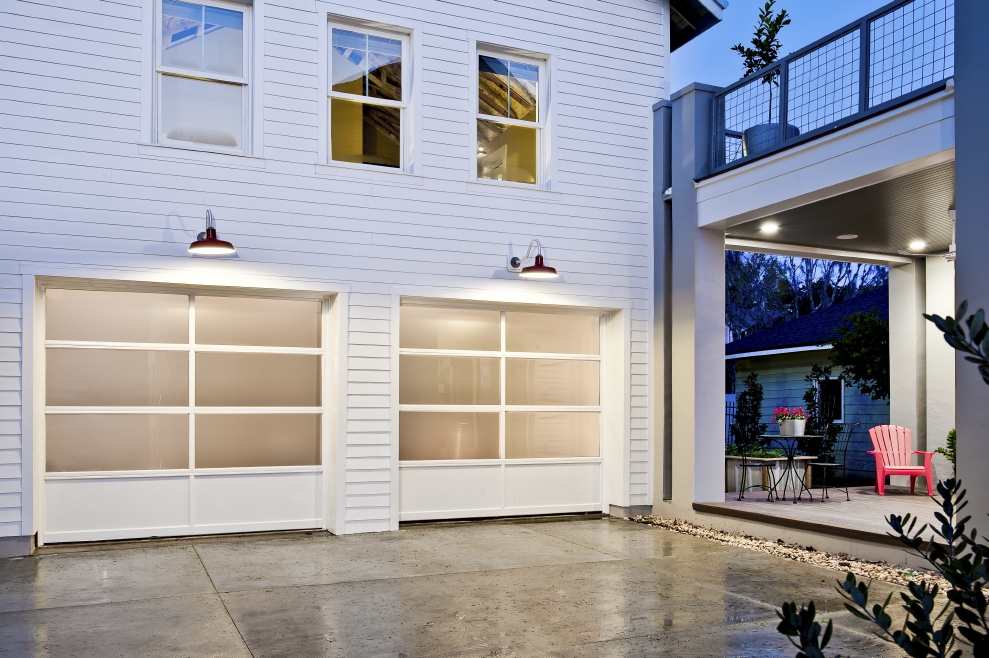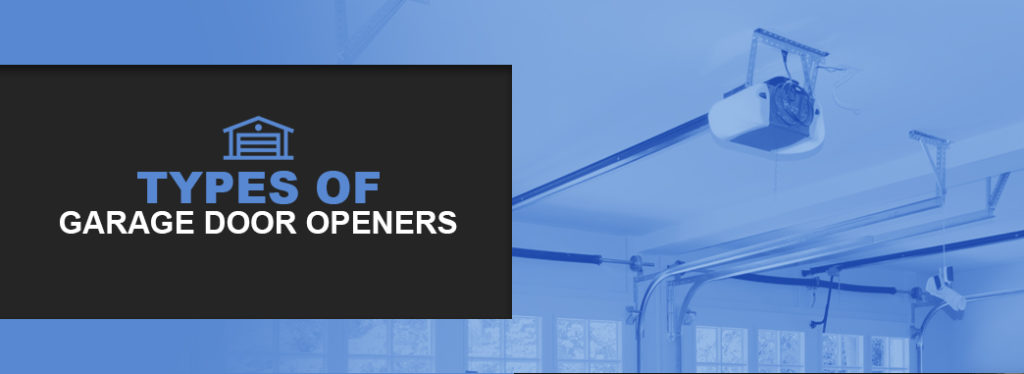
Did you know the average American garage door opens and shuts about 1,500 times per year? That’s an average of over four times per day, meaning the smooth functioning and well-being of your garage door opener are crucial to the running of your home. If this mechanism fails or stutters, it could throw your whole routine out of order, with cars trapped in or out of the garage and heavy equipment unable to move in and out.
Because this garage door opener is so critical to the continued functioning of your home, it’s worth taking the time to learn about how it works.
The first thing you should know is that not all door openers are the same, and there are multiple different garage door opener types in use today.
By learning about these different types, you can gain a better understanding of which one you have, what that entails and what you might want to upgrade to when you’re ready to replace your opener.
To help you achieve a new understanding of how your garage door works, we’ve compiled this guide to door openers, including what they are, how they differ from one another and how to decide which variety might be best for your garage.
Table of Contents
What Are the Different Types of Garage Door Opening Systems?
All the different garage door openers achieve the same basic goal — opening your garage door so you can move your car or other possessions in or out.
Despite all performing the same function, however, these varied mechanisms all have vastly different methods of achieving the same ends. Some use chains and some use belts, but all work a little bit differently.
To get a better understanding of what sets these opening systems apart, let’s take a look at each one separately.
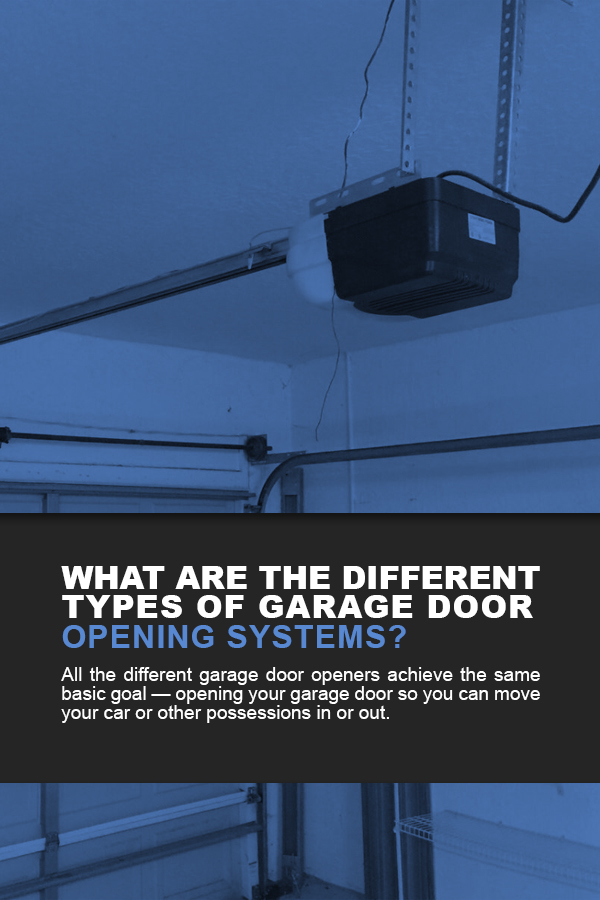
1. Chain Drive Garage Door Opener
Chain drives are the oldest technology available for garage door openers.
They’ve been around awhile, but don’t let that fool you into thinking this technology is obsolete or no longer viable. Plenty of houses are still equipped with chain drive garage door openers, and while they might not be the flashiest or the fanciest, they still get the job done.
Today’s chain drives still include the traditional chain, but can now integrate with internet technology for a more modern approach.
As the name suggests, these drives operate via a chain similar to the one on a bicycle that stretches taut when the door is shut and gains slack as the door opens.
This chain pushes — or pulls, depending on the direction of movement — a trolley that then moves the door up and down.
Even though these chain drives have been around for so many years, they are still one of the most popular and common styles out there, with many people continuing to choose this model.
How to Check to See if You have a Chain-Drive Garage Door Opener
Not sure if you have one of these? It’s easy to tell with a quick glance at the opening mechanism of your garage door. If you see a chain connecting the parts, you have a chain drive.
Pros of Chain-Drive Garage Door Openers
It isn’t hard to see why so many people still choose these chain drives over some of the more updated models currently available. Chain drives have a reputation for being highly reliable, with less chance of breaking down than other models. On top of this, because the technology is older, these models are also the most affordable option on the market. For those looking to save a bit of money, a chain drive door opener is an excellent choice.
Cons of Chain-Drive Garage Door Openers
The primary drawback of the chain drive is how noisy it is. These chains create a racket as the trolley moves up and down, often causing huge sections of the garage to vibrate from the force of the movement. While the noise may not bother some people, others find it distracting and even irritating. For this reason, chain drives are often a better choice for detached garages, where the noise will be less obtrusive to those inside the house.
2. Belt Drive Garage Door Opener
Belt drives work similarly to chain drives, except in these mechanisms, a wide rubber belt replaces the metal chain. A switch activates the belt, which then pushes and pulls the trolley up and down the track to raise and lower the garage door.
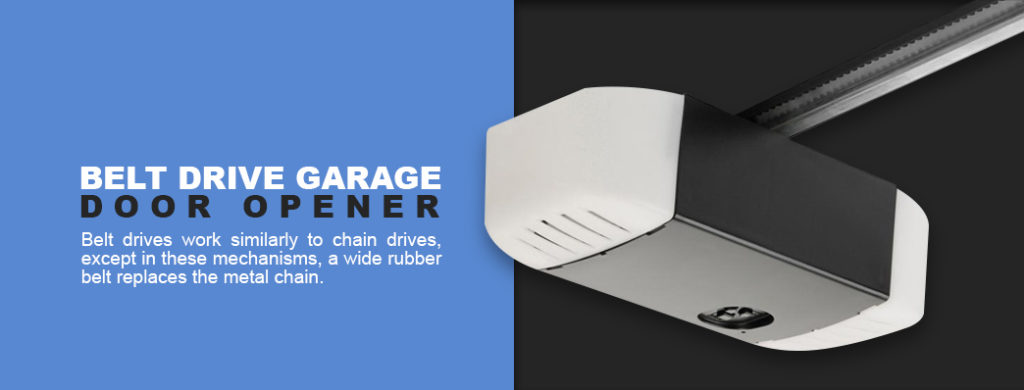
These belt drives are slightly newer technology than the old chain drives, and they represent multiple improvements over the chain drives.
There is a smaller number of moving parts involved in the operations, so there is less chance of something breaking. Over time, this leads to less maintenance, meaning fewer headaches for you and less strain on your budget.
How to Check to See if You have a Belt-Drive Garage Door Opener
Checking if your opening mechanism is a belt drive is easy. Look for the trolley that operates the door and see what it’s connected to. If it’s a wide rubber belt, you can feel sure you have a belt drive.
Pros of Belt Drive Garage Door Openers
The biggest advantage belt drives have to offer over their older brother, the chain drive, is that they’re much quieter. That makes them excellent choices for attached garages, particularly if the garage is right next to a bedroom or living room where the noise would be especially disturbing. Additionally, they’re very low-maintenance and won’t often break down.
Cons of Belt Drive Garage Door Openers
Because these belts are so quiet and efficient, they tend to run at the top of the price scale. This higher price can present an obstacle for those hoping to keep costs down, but it’s important to remember there’s more to pricing than the up-front cost. Because belt drives don’t need much maintenance, owners may end up saving money in the long run when they don’t incur repair or replacement bills further down the road.
3. Jackshaft (Sidemount) Garage Door Opener
The jackshaft is the most unlike all the other openers we’ve looked at.
The other two types — chain and belt drives — all operate via a trolley that moves up and down the rail to open and close the door. The jackshaft is in a category of its own, however, without a lot in common with the other two types.
Jackshaft openers are most noteworthy because they do not rely on any external belt or chain rail. Instead, the motor mounts directly to the torsion tube on the side of the overhead sectional door. When you hit the switch for the garage door opener, this motor activates and torsion tube and lifts/closed the door.
Pros of Jackshaft Garage Door Openers
Because the jackshaft is so uncomplicated and connected to so few moving parts, there is little to no maintenance required.
Additionally, the opener works quickly and quietly, making it a terrific option for attached garages where silence is an important factor.
For someone who is also concerned about the aesthetic of their garage and looking to minimize chains and belts looping along the ceiling, the jackshaft presents a much more streamlined presence.
Cons of Jackshaft Garage Door Openers
There are very few cons to the jackshaft, as it represents the very maximum in quietness, efficiency and minimal maintenance.
One potential con is the cost, which is certainly more expensive than a basic chain drive. Buyers can feel confident that even with this higher price tag, however, they’ll likely save money in the future due to the lack of maintenance costs.
Another possible con is that this opener is not compatible with all types of doors. The door must have a standard torsion tube and 15″ radius track, or higher, works best with this opener. It will not work with low headroom track.
Choosing a Type of Garage Door Opener
With three different primary garage door opener types to choose from, you may feel overwhelmed when it comes to deciding which is best for your home. Should you go with the simplicity of the chain drive? Are you looking for the efficiency and minimalism of the direct drive? Or, maybe it’s best to go with the quiet motion of the belt drive. To figure out which type of garage door opener is right for you, you’ll first need to ask yourself a series of questions and let your answers steer you toward the appropriate type of opener.

1. What Does Your Budget Look Like?
In a perfect world, we could all buy whatever we wanted, without any concern for the amount of money involved in the transaction. In the real world, however, everybody has a budget they can’t or shouldn’t exceed.
To start shopping for garage door openers, figure out what you can afford to spend. Do some research into garage door opener prices, see what the standard price tags look like, then ask yourself what your personal limit will be. Once you’ve decided this figure, use it to narrow your search.
2. How Important Is Noise Level?
Is your garage attached or detached? Does it directly adjoin to someone’s bedroom, or perhaps the living room? Is everyone in your family a light sleeper who will get annoyed when the garage door wakes them up? Do you typically park your car in the garage, or use it for other storage that wouldn’t require you to open the door as much?
All of these questions will dictate how important the relative noise level of the garage door opener is. If the garage is attached and directly adjacent to your living space, we recommend you look into quieter options. Unless you’re confident the noise won’t bother you, the odds are good the noise level will soon start to get on your nerves or even start disturbing your sleep.
3. Are You Adept at DIY Handiwork?
Are you the type of person who enjoys tinkering about in your home, fixing problems where they arise and updating your home’s appliances, wiring and plumbing? If so, you may not mind a type of garage door opener that occasionally needs a bit of maintenance or updating. You may even look forward to these tasks. If, on the other hand, you don’t enjoy this work and feel completely at sea with a tool kit, a door opener that doesn’t require frequent maintenance will give you far greater peace of mind.
CA Law States: Garage Doors Have to Work During a Power Outage
As a result of the garage door accidents during 2017 California Wildfires and again during the 2018 CA wildfires, CA requires all garage door openers to come with a battery backup. This bill is aimed at preventing the possibility of a garage door not opening during a power outage.
If you’re looking for a new garage door opener in San Diego County, CA, make sure that the opener you’re getting installed is equipped with a battery backup.
Easy Open Door recommends getting your garage door serviced on an annual basis so that you can be sure that your opener is ready to go in case of an emergency.
Our team can recommend and install a new garage door opener with a battery backup for your home in San Diego County if your current opener is not equipped with a garage opener battery backup.
Find the Right Garage Door Opener for Your San Diego Home
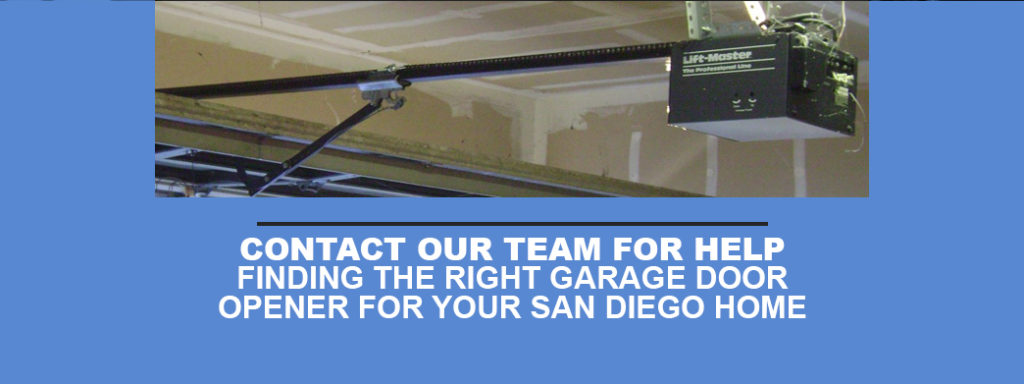
Are you in the market for a new garage door opener? Looking to upgrade your existing model? Many factors will play into choosing your next door drive, but we want to be there with you for every step of your journey. Here at Easy Open Door, all our employees have a minimum of 15 years of experience in the field, making us your ideal companions for walking you through a potentially confusing process.
We’re a small family-owned company, so you can be sure you’ll never feel like “just another customer” lost in the shuffle of an enormous corporation. We care about all our customers and make it our business to ensure everyone who walks through our doors has the best experience we can provide.
To get started with your shopping experience, contact us today for your free estimate.


